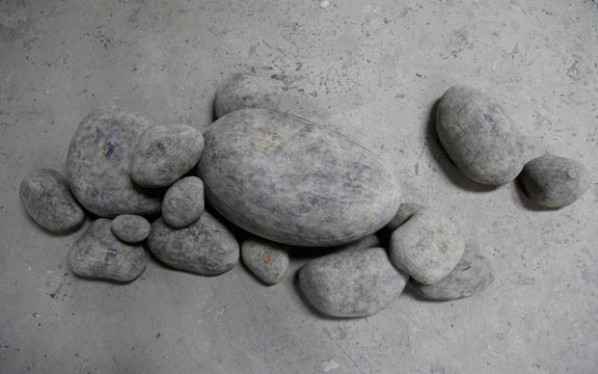
Li Hongbo, Stone, 2012; paper, Dimensions variable
The term Jiang Qi (Chinese:匠气)which can be roughly defined as a style of working in which the emphasis is on technique, shows how the cultural mainstream harbors negative attitudes towards the crafts. In spite of this the craftsman’s originality is praised, which creates a contradiction – the craftsman must have “xin” (referring to soul) and “qi” (referring to spirit), and “xin” is connected to “qi”, so why judge it negatively?
For contemporary art with its disdain for technique, excessive self-confidence and addiction to concepts, the crafts are either regarded as being in opposition to the avant-garde, or serve as supplements in conceptual art expression. Apart from this, in mainstream contemporary art, meaningless and low-technique cultural productions are widely popular. In the history of the humanities, the masterpieces are still immortal, but will the skills and techniques which have contributed to historical developments in the arts evaporate in the new cultural environment?
Li Hongbo, Wei Ming, Wang Lei and Ye Sen were not expected to be spokesmen for avant-garde or contemporary art. Their artistic practice did not originate in concepts, instead it was based on traditional craft methods. However, they are well aware of their position in the art world, in the current multi-cultural and international era and with the rich inheritance of traditional Chinese culture. Consequently their works are not meant to create a mirage of the traditional farming culture of imperial China, but rather to explore the connection between contemporary spirit and creativity in order to establish a new means of creation. They no longer consider their art education as the only creative resource for their artistic expression, but instead they enter the lives of ordinary people and migratory craftsmen and look to techniques established in traditional workshops for inspiration.
Many people refer to Li Hongbo, Wei Ming, Wang Lei and Ye Sen as the “Big Four” in experimental art, which encouraged them in their artistic creations. Clearly, as contemporary artists, they cannot simply be craftsmen, but the impact of traditional craft techniques and spirit has strengthened their abilities.
Li Hongbo –Paper Gourd Garland Maker
Wei Ming –Damaged Objects Restorer
Wang Lei –Paper Towel Tailor
Ye Sen –Wood Chain Maker
Li Hongbo’s work Flexibility (伸缩性) has attracted considerable attention both nationally and internationally, strengthening his confidence with further exploration of the paper garland technique. He created Old Bottles (古瓶), World (世界), A Tree (一棵树), Broken Wood (断木), Hard Stone (顽石), Weapon Analysis (枪的解析), in which he transformed the garland technique, an out-of-date traditional folk craft, into a contemporary means of expression. The latest work Hard Stone is based on real stones that the artist found. These stones have been polished by running water over them for thousands of years. Scars and marks are still visible on the smooth surface of the stones. During his artistic recreation, the artist turned the unruly stones into gentle forms, as if they are telling some sad stories. Weapon Analysis triggers memories of war and reflections on its horrors. Initially, the artist proceeded as if he were producing the kind of blueprints used in an arsenal for the manufacture of weapons. This approach soon underwent a rapid transformation as the weapons were transformed into rainbow colored plowshares, dangerous weapons becoming festive decorations for the viewer’s delectation.
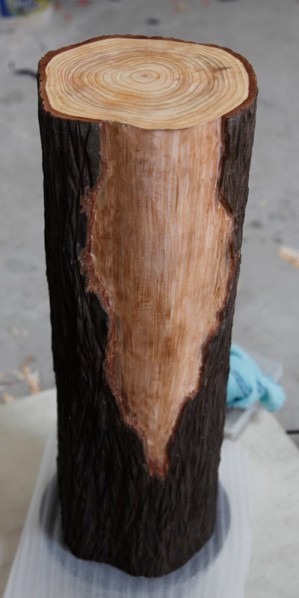
Li Hongbo, Wood, 2012; paper, 65× 22 cm
Wei Ming is also expanding the range of his restoration work to include porcelain. Damaged Duchamp’s Fountain (打碎杜尚的小便池) does not question the validity of a masterpiece, but reinforces notions of the restoration of the material world. Outdated urinals are generally not found in today’s restrooms. If people feel sympathy for the fountain, it must develop from the process of restoration and the energy and emotion put into it. A mirror is an object of daily life used for reflecting faces and body shapes. It is very fragile, just like some relationships. Thus sometimes the mirror is used as a metaphor for the reunion of a family or a couple, the so-called “po jing chong yuan” (a broken mirror was restored). The artist uses metal pins to close the cracks in the mirror, a method with very successful results. In this process, the mirror has lost its original smoothness, but has gained new material and a new meaning.

Wei Ming, Love Shadow No. 1, No. 2, No. 3, 2012; Ready-made object damaged and restored, 170 x 63 x 4cm in each
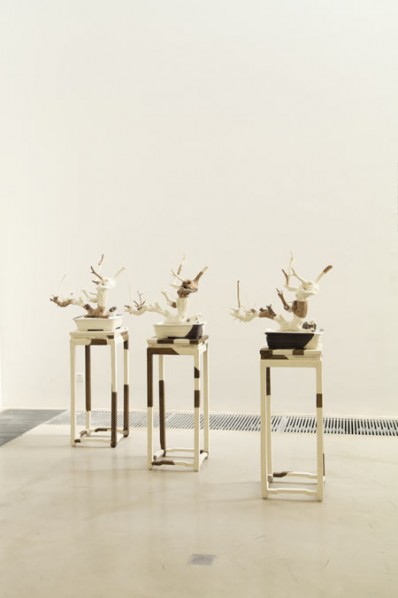
Wei Ming, Bonsai: Restore, Restore, Restore, 2012; Ready-made object damaged and restored, 300 x 160 x 40 cm
Wang Lei’s use of the braid technique in his work Hand-Woven Toilet Paper (手织手纸) gained national and international recognition when it was first exhibited. Not surprisingly, this led to increasing pressure on him as he considered his future artistic career. Recently, Wang Lei has been making a new series of works, which are full of surprises. Although the series is still based on the forms of old costumes, he adds newspaper clippings into the process of tailoring, twisting and braiding, which injects social and political meanings into the clothes. As a result the clothes have additional visual imagery besides being merely clothes, a newspaper, a figure (or it could be other things), which indicate that society has different ways of receiving the news, clearly, vaguely, or fragmentarily. The newspaper as a ready-made object in Lei’s woven clothes has reinforced the social relevance of his work, resulting in braids that are more than merely braids.
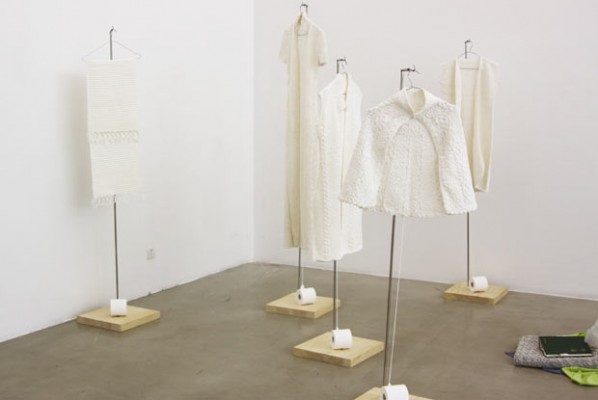
Wang Lei, Hand-Woven Toilet Paper (including 5 pieces), 2012; toilet paper, Dimensions variable
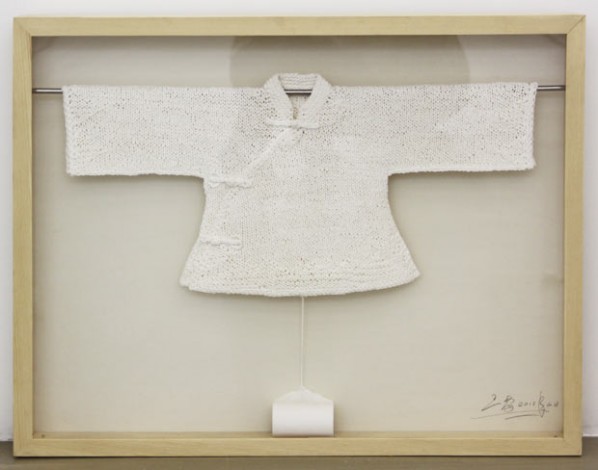
Wang Lei, Hand- Woven Toilet Paper – Children’s Clothes, 2012; toilet paper, 85 x 65 x 10 cm
Ye Sen is neither simple nor complex. He combines the two, and the mixture represents him in his entirety as in his early work Analysis (分析). Later he created Hoisting Pulley (起重滑轮), Two Pairs of Chairs (两把椅子), Rolling Blind (卷帘) and related works which push Jiang Qi further and further into a complicated and incredible zone. The latest work Chair’s Craft Analysis (椅子的匠作分析) shows something different. All the components in this work were carved from a single huge log, using the technique known as tenon-and mortise. The chain in the work separates the other components but does not isolate them, accomplishing the dual analysis of a log and a chair. Without question, this is a complicated work by a thinking artist, but it is simple as well, when you do not subject it to analysis, but rather regard it as a chair on which one could sit.

Ye Sen, Pair of Chairs, 2012; Jichimu wood, 110 x 80 x 20 cm
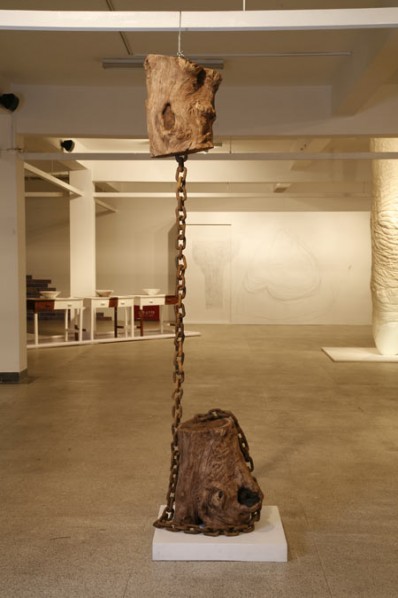
Ye Sen, Analysis 5, 2012; Jichimu wood, 42 x 42 x 350 cm
“The Revolution has not yet succeeded. Comrades, you must carry on.”
I cannot help myself from quoting Dr. Sun Yat-sen for the conclusion. This paper is rightly just an introduction, the main text being the works themselves.
As students I have recently taught, I wish them years of continuous creativity.
I praise their Jiang Qi today, and I wish for their phenomenal Jiang Qi in the future.
by Lv Shengzhong
June 21, 2012, Midsummer’s Day
About the Exhibition
Venue: Chambers Fine Art
Address: Red No.1-D, Cao Changdi,Chaoyang District,Beijing, 100015, China
Tel: +86 10 5127 3298
Fax: +86 10 5127 3298
Courtesy of the artists and Chamber Fine Art, for further information please visit www.chambersfineart.com.




























